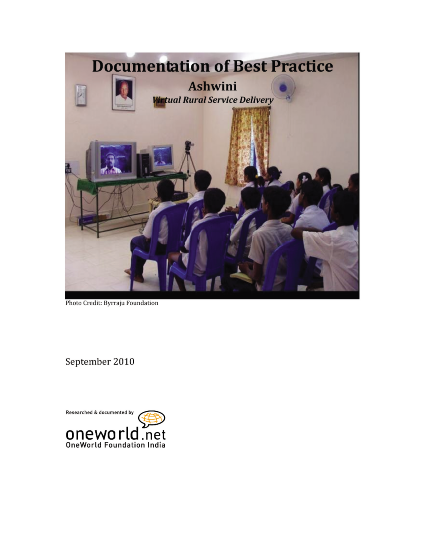
In 2004, Byrraju Foundation’s proof of concept proposing a virtual platform for provision of urban services in rural areas became the winner of the World Bank challenge. The prize was two years of funding for a pilot programme they became known as Ashwini. Partners Medialab Asia and National Institute for Smart Governance (NISG) helped to implement two Ashwini centres. In 2006, the United Nations Development Programme (UNDP) supplied funding for the upscaling of Ashwini to 32 centres covering 116 villages in the East Godavri and West Godavri districts. Ashwini was designed according to a ‘hub and spoke’ model, where a trainer conducts its lessons from one studio and communicates with two to three surrounding villages through a two-way video conference. For example, a teacher would conduct lessons from the ‘hub’ city while students could tune in to the network from ‘spoke’ localities. Prior to Ashwini, service provision required trainers located in cities to physically visit those in remote localities, a costly method in terms of both time and money. Implementation of Ashwini was incremental, namely because of the complex ICT infrastructure envisioned at the time. Technologies available to serve the purpose Ashwini aimed to fulfil have changed a great deal since the programme’s outset. Therefore, it is important to note that the processes described here are not necessarily the most practical today. However, the lesson that can be taken from this is that egovernance projects must always consider the future possibility of technology change and hence, be able to adapt with the times. Key to Ashwini’s implementation was establishing ‘last mile connectivity’ – the final step of getting the network up and running. With the help of Medialab Asia, the necessary antenna and tower technology was developed. After the connectivity challenge was overcome, video conferencing equipment was selected and purchased for use. Buildings for centres were donated bringing the initial lump-sum investment to around 3.5 to 4 lakh, including wireless equipment, furniture for centres (30 to 40 person capacity) and conferencing equipment. Today, the Byrraju Foundation believes that the social objectives of Ashwini have been achieved, but the economic side remains in progress since eight out of the 32 centres have not yet reached their breakeven point. Implementers, however, remain optimistic that economic goals will be achieved because the demand gap is not expected to shrink for a number of reasons. First, there is substantial space for efforts to create further programme awareness. Second, the service model can and should be revamped to offer free services at the start of any new activity. Third, technology savings will rise over time. Last, mobile solutions will bridge the digital divide and have the potential to be leveraged for Ashwini services.
Resource collections
- Prioritisation
- UN Habitat - Urban Response Collection
- Urban Response - Urban Crisis Preparedness and Risk Reduction
- Urban Response Collection - Community Engagement and Social Cohesion
- Urban Response Collection - Economic Recovery
- Urban Response Collection - Environment and Climate Change
- Urban Response Collection - Housing, Land and Property
- Urban Response Collection - Urban Crisis Response, Recovery and Reconstruction
- Urban Response Collection - Urban Resilience